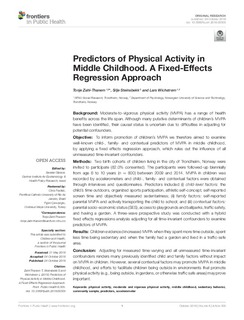| dc.description.abstract | Background: Moderate-to-vigorous physical activity (MVPA) has a range of health benefits across the life span. Although many putative determinants of children's MVPA have been identified, their causal status is uncertain due to difficulties in adjusting for potential confounders. Objective: To inform promotion of children's MVPA we therefore aimed to examine well-known child-, family- and contextual predictors of MVPA in middle childhood, by applying a fixed effects regression approach, which rules out the influence of all unmeasured time-invariant confounders. Methods: Two birth cohorts of children living in the city of Trondheim, Norway were invited to participate (82.0% consented). The participants were followed-up biennially from age 6 to 10 years (n = 800) between 2009 and 2014. MVPA in children was recorded by accelerometers and child-, family- and contextual factors were obtained through interviews and questionnaires. Predictors included (i) child-level factors: the child's time outdoors, organized sports participation, athletic self-concept, self-reported screen time and objectively measured sedentariness; (ii) family factors: self-reported parental MVPA and actively transporting the child to school; and (iii) contextual factors: parental socio-economic status (SES), access to playgrounds and ballparks, traffic safety, and having a garden. A three-wave prospective study was conducted with a hybrid fixed effects regressions analysis adjusting for all time-invariant confounders to examine predictors of MVPA. Results: Children evidenced increased MVPA when they spent more time outside, spent less time being sedentary and when the family had a garden and lived in a traffic-safe area. Conclusion: Adjusting for measured time-varying and all unmeasured time-invariant confounders renders many previously identified child and family factors without impact on MVPA in children. However, several contextual factors may promote MVPA in middle childhood, and efforts to facilitate children being outside in environments that promote physical activity (e.g., being outside, in gardens, or otherwise traffic safe areas) may prove important. | |
